
There definitely was something orange back here, and not just anything orange. This is a DM8/9 – ‘The Carrot’, hence the livery. These are the last surviving examples of this train built around 1965 and abandoned around 1990. A restoration project has begun, but it has been interrupted due to issues between the members of the preservation society.

So there are two units left of this thing. And they’re both stored here. Let’s try to board.

The middle cars were fitted with a kitchen and a first class cabin in the 1970’s. This was probably the kitchen before the restaurant cars.

The car was in a pretty bad condition, and this was only underlined by the removed segment of the wall.

This was probably back in the days, when there were still ads onboard trains. I can’t remember this era, so this was probably very long ago.

And so we were in the passenger compartment. Unfortunately everything was covered in mold. The smell was horrible, almost unbearable. And unfortunately this view seemed beyond resque.

Behind the first one was the second unit. And I repeat, these two are the only surviving examples of this train type. There was a third one stored in a shed at a far away station. The shed collapsed and the unit was towed to a depot. There it suffered extensive vandalism and was scrapped.

Here they have at least tried to preserve things by storing seat frames. However, as you can see, things look a lot like Camembert. Mold has taken over this car as well.

So this is what the cockpit of ‘The Carrot’ looks like.

A close up at one of the panels. There certainly was a time, when all the shit of operating a train was supposed to be written in a notebook.

And then of course there were meters and indicators, which I couldn’t understand.

A paper, which once was for reporting safety issues.

Another look at the cockpit of ‘The Carrot’.

And the look back where I came from.

Another old passenger car.

The interior of a first class cabin in an old carriage. The outside of it is painted blue and grey, and they are an iconic part of Finnish railroad history. I’ve never been to the first class cabins, but I think they looked a bit more modern during my era than this.

The orange seats and fake wood panels just scream 1970’s.

I mean look at this vintage. I would have loved to live in an era, where trains looked like this.

Unfortunately mold is slowly finding its way to this car too.

The variety of trains and cars in the depot was amazing. On the right hand track you can see another ‘Flat Cap’.
To me the depot was even more interesting than the steam locomotive park. I could have spent hours there, but unfortunately it was time to continue our journey.
The control panel you showed in this post is from an early EMD locomotive. Basically, you are controlling two systems here; an electric diesel generator as well as the amount of electricity delivered to the motors. Modern engines work more efficiently and have computer controlled diesel generators, so basically all the operator has to do is control the speed and braking using levers.
I only know this because I have had a lifelong fascination with trains ever since I was a little girl. I also knew people who worked in the railroad industry, and they were kind enough to tell me about how trains work. These folks told me that in modern trains, there are three main levers; a reverser that moves the train forwards (or backwards), a throttle for speed, and a brake to slow things down. It’s a simple setup but it also requires a LOT of patience and understanding of physics and engineering to make it all happen.
Thank you, Thomas! This was all new information to me!
I remember you telling about your fascination with trains. I had this post written already back then and was only waiting to get to share this post with you 😉 There are a few abandoned railway stations coming up, too.
Abandoned railroad stations? Goodie-goodie! I’m excited! 🙂